Synthesis and Characterization of Tetracycline Loaded Methionine-Coated NiFe2O4 Nanoparticles for Anticancer and Antibacterial Applications
Abstract
:1. Introduction
2. Materials and Methods
2.1. Materials
2.2. Fabrication of Met-NiFe2O4 Nanoparticles
2.3. Physicochemical Characterization Studies
2.4. Average Hydrodynamic Size and Zeta Potential Measurement
2.5. Tetracycline Loading and Release Behavior
2.6. In Vitro Cytotoxicity
2.7. Antibacterial Activity
2.8. Statistical Analysis
3. Results and Discussion
3.1. Synthesis and Physicochemical Characterizations of Tet-Met-NiFe2O4 Nanoparticles
3.1.1. XRD Analysis
3.1.2. FT-IR Spectral Analysis
3.1.3. Magnetic Property Analysis
3.1.4. Size and Morphology Analysis
3.1.5. Thermogravimetric Analysis
3.2. Size Distribution and Zeta Potential Measurement
3.3. Drug Loading and Release Study
3.4. Cytotoxicity Studies
3.5. Antibacterial Activity
4. Conclusions
Author Contributions
Funding
Institutional Review Board Statement
Informed Consent Statement
Data Availability Statement
Conflicts of Interest
References
- Mittal, D.; Kumar, A.; Balasubramaniam, B.; Thakur, R.; Siwal, S.S.; Saini, R.V.; Gupta, R.K.; Saini, A.K. Synthesis of Biogenic Silver Nanoparticles Using Plant Growth-Promoting Bacteria: Potential Use as Biocontrol Agent Against Phytopathogens. Biomater. Polym. Horiz. 2021, 1, 22–31. [Google Scholar] [CrossRef]
- Sleigh, S.H.; Barton, C.L. Repurposing Strategies for Therapeutics. Pharm. Med. 2012, 24, 151–159. [Google Scholar] [CrossRef]
- Da Cunha, E.F.F.; Ramalho, T.C.; Josa, D.; Caetano, M.S.; de Souza, T.C.S. Targeting Inhibition of COX-2: A Review of Patents, 2002–2006. Recent. Pat. Inflamm. Allergy Drug Discov. 2007, 1, 108–123. [Google Scholar] [CrossRef]
- Behdad, R.; Pargol, M.; Mirzaie, A.; Karizi, S.Z.; Noorbazargan, H.; Akbarzadeh, I. Efflux Pump Inhibitory Activity of Biologically Synthesized Silver Nanoparticles against Multidrug-Resistant Acinetobacter Baumannii Clinical Isolates. J. Basic Microbiol. 2020, 60, 494–507. [Google Scholar] [CrossRef]
- Hedayati Ch, M.; Abolhassani Targhi, A.; Shamsi, F.; Heidari, F.; Salehi Moghadam, Z.; Mirzaie, A.; Behdad, R.; Moghtaderi, M.; Akbarzadeh, I. Niosome-Encapsulated Tobramycin Reduced Antibiotic Resistance and Enhanced Antibacterial Activity against Multidrug-Resistant Clinical Strains of Pseudomonas Aeruginosa. J. Biomed. Mater. Res. A 2021, 109, 966–980. [Google Scholar] [CrossRef]
- Mirzaie, A.; Peirovi, N.; Akbarzadeh, I.; Moghtaderi, M.; Heidari, F.; Yeganeh, F.E.; Noorbazargan, H.; Mirzazadeh, S.; Bakhtiari, R. Preparation and Optimization of Ciprofloxacin Encapsulated Niosomes: A New Approach for Enhanced Antibacterial Activity, Biofilm Inhibition and Reduced Antibiotic Resistance in Ciprofloxacin-Resistant Methicillin-Resistance Staphylococcus Aureus. Bioorg. Chem. 2020, 103, 104231. [Google Scholar] [CrossRef]
- Akbarzadeh, I.; Tavakkoli Yaraki, M.; Bourbour, M.; Noorbazargan, H.; Lajevardi, A.; Sadat Shilsar, S.M.; Heidari, F.; Mousavian, S.M. Optimized Doxycycline-Loaded Niosomal Formulation for Treatment of Infection-Associated Prostate Cancer: An in-Vitro Investigation. J. Drug Deliv. Sci. Technol. 2020, 57, 101715. [Google Scholar] [CrossRef]
- Ghafelehbashi, R.; Akbarzadeh, I.; Tavakkoli Yaraki, M.; Lajevardi, A.; Fatemizadeh, M.; Heidarpoor Saremi, L. Preparation, Physicochemical Properties, in Vitro Evaluation and Release Behavior of Cephalexin-Loaded Niosomes. Int. J. Pharm. 2019, 569, 118580. [Google Scholar] [CrossRef]
- Ghomi, Z.; Tafvizi, F.; Naseh, V.; Akbarzadeh, I. Effect of Artemisia Ciniformis Extract on Expression of NorA Efflux Pump Gene in Ciprofloxacin Resistant Staphylococcus Aureus by Real Time PCR. Iran. J. Med. Microbiol. 2020, 14, 55–69. [Google Scholar] [CrossRef] [Green Version]
- Etebu, E.; Arikekpar, I. Antibiotics: Classification and Mechanisms of Action with Emphasis on Molecular Perspectives. IJAMBR 2016, 4, 90–101. [Google Scholar]
- Kohanski, M.A.; Dwyer, D.J.; Collins, J.J. How Antibiotics Kill Bacteria: From Targets to Networks. Nat. Rev. Microbiol. 2010, 8, 423–435. [Google Scholar] [CrossRef] [Green Version]
- Padiyara, P.; Inoue, H.; Sprenger, M. Global Governance Mechanisms to Address Antimicrobial Resistance. Infect. Dis. 2018, 11, 1178633718767887. [Google Scholar] [CrossRef] [Green Version]
- Singh, P.; Garg, A.; Pandit, S.; Mokkapati, V.R.S.S.; Mijakovic, I. Antimicrobial Effects of Biogenic Nanoparticles. Nanomaterials 2018, 8, 1009. [Google Scholar] [CrossRef] [Green Version]
- Wu, X.; Xu, Z.; Huang, Z.; Shao, C. Large Volume Sample Stacking of Cationic Tetracycline Antibiotics toward 10 Ppb Level Analysis by Capillary Electrophoresis with UV Detection. Electrophoresis 2016, 37, 2963–2969. [Google Scholar] [CrossRef]
- Du, F.; Zheng, X.; Sun, L.; Qin, Q.; Guo, L.; Ruan, G. Development and Validation of Polymerized High Internal Phase Emulsion Monoliths Coupled with HPLC and Fluorescence Detection for the Determination of Trace Tetracycline Antibiotics in Environmental Water Samples. J. Sep. Sci. 2015, 38, 3774–3780. [Google Scholar] [CrossRef]
- Akbarzadeh, I.; Fatemizadeh, M.; Heidari, F.; Niri, N.M. Niosomal Formulation for Co-Administration of Hydrophobic Anticancer Drugs into MCF-7 Cancer Cells. Arch. Adv. Biosci. 2020, 11, 1–9. [Google Scholar] [CrossRef]
- Akbarzadeh, I.; Saremi Poor, A.; Yaghmaei, S.; Norouzian, D.; Noorbazargan, H.; Saffar, S.; Ahangari Cohan, R.; Bakhshandeh, H. Niosomal Delivery of Simvastatin to MDA-MB-231 Cancer Cells. Drug Dev. Ind. Pharm. 2020, 46, 1535–1549. [Google Scholar] [CrossRef]
- Shad, P.M.; Karizi, S.Z.; Javan, R.S.; Mirzaie, A.; Noorbazargan, H.; Akbarzadeh, I.; Rezaie, H. Folate Conjugated Hyaluronic Acid Coated Alginate Nanogels Encapsulated Oxaliplatin Enhance Antitumor and Apoptosis Efficacy on Colorectal Cancer Cells (HT29 Cell Line). Toxicol. Vitr. 2020, 65, 104756. [Google Scholar] [CrossRef]
- Shirzad, M.; Jamehbozorgi, S.; Akbarzadeh, I.; Aghabozorg, H.R.; Amini, A. The Role of Polyethylene Glycol Size in Chemical Spectra, Cytotoxicity, and Release of PEGylated Nanoliposomal Cisplatin. ASSAY Drug Dev. Technol. 2019, 17, 231–239. [Google Scholar] [CrossRef]
- Bhattacharyya, S.; Kudgus, R.A.; Bhattacharya, R.; Mukherjee, P. Inorganic Nanoparticles in Cancer Therapy. Pharm. Res. 2011, 28, 237. [Google Scholar] [CrossRef] [Green Version]
- Ahmad, A.; Othman, I.; Md Zain, A.; Chowdhury, E. Controlled Release of Insulin in Blood from Strontium-Substituted Carbonate Apatite Complexes. Curr. Drug Deliv. 2015, 12, 210–222. [Google Scholar] [CrossRef]
- Roca, A.G.; Carmona, D.; Miguel-Sancho, N.; Bomatí-Miguel, O.; Balas, F.; Piquer, C.; Santamaría, J. Surface Functionalization for Tailoring the Aggregation and Magnetic Behaviour of Silica-Coated Iron Oxide Nanostructures. Nanotechnology 2012, 23, 155603. [Google Scholar] [CrossRef]
- Yiu, H.H.P. Engineering the Multifunctional Surface on Magnetic Nanoparticles for Targeted Biomedical Applications: A Chemical Approach. Nanomedicine 2011, 6, 1429–1446. [Google Scholar] [CrossRef]
- Cheong, S.; Ferguson, P.; Feindel, K.W.; Hermans, I.F.; Callaghan, P.T.; Meyer, C.; Slocombe, A.; Su, C.-H.; Cheng, F.-Y.; Yeh, C.-S.; et al. Simple Synthesis and Functionalization of Iron Nanoparticles for Magnetic Resonance Imaging. Angew. Chem. 2011, 123, 4292–4295. [Google Scholar] [CrossRef]
- Cho, N.H.; Cheong, T.C.; Min, J.H.; Wu, J.H.; Lee, S.J.; Kim, D.; Yang, J.S.; Kim, S.; Kim, Y.K.; Seong, S.Y. A Multifunctional Core-Shell Nanoparticle for Dendritic Cell-Based Cancer Immunotherapy. Nat. Nanotechnol. 2011, 6, 675–682. [Google Scholar] [CrossRef]
- Farokhzad, O.C.; Langer, R. Impact of Nanotechnology on Drug Delivery. ACS Nano 2009, 3, 16–20. [Google Scholar] [CrossRef]
- Davis, M.E.; Chen, Z.; Shin, D.M. Nanoparticle Therapeutics: An Emerging Treatment Modality for Cancer. Nat. Rev. Drug Discov. 2008, 7, 771–782. [Google Scholar] [CrossRef]
- Sanpo, N.; Berndt, C.C.; Wang, J. Microstructural and Antibacterial Properties of Zinc-Substituted Cobalt Ferrite Nanopowders Synthesized by Sol-Gel Methods. J. Appl. Phys. 2012, 112, 084333. [Google Scholar] [CrossRef]
- Bae, S.; Lee, S.W.; Hirukawa, A.; Takemura, Y.; Jo, Y.H.; Lee, S.G. AC Magnetic-Field-Induced Heating and Physical Properties of Ferrite Nanoparticles for a Hyperthermia Agent in Medicine. IEEE Trans. Nanotechnol. 2009, 8, 86–94. [Google Scholar] [CrossRef]
- Naseri, M.G.; Saion, E.B.; Ahangar, H.A.; Hashim, M.; Shaari, A.H. Simple Preparation and Characterization of Nickel Ferrite Nanocrystals by a Thermal Treatment Method. Powder Technol. 2011, 212, 80–88. [Google Scholar] [CrossRef]
- Perron, H.; Mellier, T.; Domain, C.; Roques, J.; Simoni, E.; Drot, R.; Catalette, H. Structural Investigation and Electronic Properties of the Nickel Ferrite: A Periodic Density Functional Theory Approach. J. Phys. Condens. Matter 2007, 19, 346219. [Google Scholar] [CrossRef]
- Ling, D.; Lee, N.; Hyeon, T. Chemical Synthesis and Assembly of Uniformly Sized Iron Oxide Nanoparticles for Medical Applications. ACC Chem. Res. 2015, 48, 1276–1285. [Google Scholar] [CrossRef] [PubMed]
- Pourgolmohammad, B.; Masoudpanah, S.M.; Aboutalebi, M.R. Synthesis of CoFe2O4 Powders with High Surface Area by Solution Combustion Method: Effect of Fuel Content and Cobalt Precursor. Ceram. Int. 2017, 43, 3797–3803. [Google Scholar] [CrossRef]
- Wang, G.; Zhou, F.; Li, X.; Li, J.; Ma, Y.; Mu, J.; Zhang, Z.; Che, H.; Zhang, X. Controlled Synthesis of L-Cysteine Coated Cobalt Ferrite Nanoparticles for Drug Delivery. Ceram. Int. 2018, 44, 13588–13594. [Google Scholar] [CrossRef]
- Angadi, V.J.; Choudhury, L.; Sadhana, K.; Liu, H.L.; Sandhya, R.; Matteppanavar, S.; Rudraswamy, B.; Pattar, V.; Anavekar, R.V.; Praveena, K. Structural, Electrical and Magnetic Properties of Sc3+ Doped Mn-Zn Ferrite Nanoparticles. J. Magn. Magn. Mater. 2017, 424, 1–11. [Google Scholar] [CrossRef]
- Saykova, D.; Saikova, S.; Mikhlin, Y.; Panteleeva, M.; Ivantsov, R.; Belova, E. Synthesis and Characterization of Core–Shell Magnetic Nanoparticles NiFe2O4@Au. Metals 2020, 10, 1075. [Google Scholar] [CrossRef]
- Majed, H.M.; Khalef, H.Y.; Awadh, H.A.; Noomi, B.S.; Jafar, N.A.; Hadi, K.A. Evaluation the Safety and Synergistic Effect of NiFe2O4 Nanoparticles with Antibiotic against Pseudomonas Aeruginosa. Iraqi J. Vet. Sci. 2021, 35, 71–77. [Google Scholar] [CrossRef]
- Gheidari, D.; Mehrdad, M.; Maleki, S.; Hosseini, S. Synthesis and Potent Antimicrobial Activity of CoFe2O4 Nanoparticles under Visible Light. Heliyon 2020, 6, e05058. [Google Scholar] [CrossRef]
- Sibuh, B.Z.; Gupta, P.K.; Taneja, P.; Khanna, S.; Sarkar, P.; Pachisia, S.; Khan, A.A.; Jha, N.K.; Dua, K.; Singh, S.K.; et al. Synthesis, In Silico Study, and Anti-Cancer Activity of Thiosemicarbazone Derivatives. Biomedicines 2021, 9, 1375. [Google Scholar] [CrossRef]
- Kumar Trivedi, M. Spectroscopic Characterization of Chloramphenicol and Tetracycline: An Impact of Biofield Treatment. Pharm. Anal. Acta 2015, 6, 395. [Google Scholar] [CrossRef]
- Eshrati Yeganeh, F.; Yousefi, M.; Hekmati, M.; Bikhof, M. An Experimental Research on PH-Responsive Amino Acid-Coated Ni(1−x)CoxFe2O4 Nanoparticles as a Nano-Carrier for Drug Delivery and Biological Applications. Chem. Pap. 2021, 75, 6047–6057. [Google Scholar] [CrossRef]
- Brandenberger, C.; Mühlfeld, C.; Ali, Z.; Lenz, A.G.; Schmid, O.; Parak, W.J.; Gehr, P.; Rothen-Rutishauser, B. Quantitative Evaluation of Cellular Uptake and Trafficking of Plain and Polyethylene Glycol-Coated Gold Nanoparticles. Small 2010, 6, 1669–1678. [Google Scholar] [CrossRef] [PubMed]
- Jamshidifar, E.; Eshrati Yeganeh, F.; Shayan, M.; Tavakkoli Yaraki, M.; Bourbour, M.; Moammeri, A.; Akbarzadeh, I.; Noorbazargan, H.; Hossein-Khannazer, N. Super Magnetic Niosomal Nanocarrier as a New Approach for Treatment of Breast Cancer: A Case Study on SK-BR-3 and MDA-MB-231 Cell Lines. Int. J. Mol. Sci. 2021, 22, 7948. [Google Scholar] [CrossRef] [PubMed]
- Cicuéndez, M.; Doadrio, J.C.; Hernández, A.; Portolés, M.T.; Izquierdo-Barba, I.; Vallet-Regí, M. Multifunctional PH Sensitive 3D Scaffolds for Treatment and Prevention of Bone Infection. Acta Biomater. 2018, 65, 450–461. [Google Scholar] [CrossRef] [PubMed] [Green Version]
- Zhang, J.; Yuan, Z.F.; Wang, Y.; Chen, W.H.; Luo, G.F.; Cheng, S.X.; Zhuo, R.X.; Zhang, X.Z. Multifunctional Envelope-Type Mesoporous Silica Nanoparticles for Tumor-Triggered Targeting Drug Delivery. J. Am. Chem. Soc. 2013, 135, 5068–5073. [Google Scholar] [CrossRef] [PubMed]
- Abbaszadegan, A.; Ghahramani, Y.; Gholami, A.; Hemmateenejad, B.; Dorostkar, S.; Nabavizadeh, M.; Sharghi, H. The Effect of Charge at the Surface of Silver Nanoparticles on Antimicrobial Activity against Gram-Positive and Gram-Negative Bacteria: A Preliminary Study. J. Nanomater. 2015, 2015, 53. [Google Scholar] [CrossRef] [Green Version]
- Yeganeh, F.E.; Yeganeh, A.E.; Yousefi, M.; Far, B.F.; Akbarzadeh, I.; Bokov, D.O.; Raahemifar, K.; Soltani, M. Formulation and Characterization of Poly (Ethylene Glycol)-Coated Core-Shell Methionine Magentic Nanoparticles as a Carrier for Naproxen Delivery: Growth Inhibition of Cancer Cells. Cancer 2022, 14, 1797. [Google Scholar] [CrossRef]
- Sinha, S.; Sibuh, B.Z.; Mishra, A.; Pant, K.; Tomar, S.; Anand, J.; Gupta, P.K. Synthesis, Characterization and Remedial Action of Biogenic p-Ag Nanoparticles. Nanofabrication 2022, 1–6. [Google Scholar] [CrossRef]
- Thakur, N.; Anu; Kumar, K.; Thakur, V.K.; Soni, S.; Kumar, A.; Samant, S.S. Antibacterial and Photocatalytic Activity of Undoped and (Ag, Fe) co-doped CuO Nanoparticles via Microwave Assisted Method. Nanofabrication 2022, 1–27. [Google Scholar] [CrossRef]
- Losasso, C.; Belluco, S.; Cibin, V.; Zavagnin, P.; Mičetić, I.; Gallocchio, F.; Zanella, M.; Bregoli, L.; Biancotto, G.; Ricci, A. Antibacterial Activity of Silver Nanoparticles: Sensitivity of Different Salmonella Serovars. Front. Microbiol. 2014, 5, 227. [Google Scholar] [CrossRef] [Green Version]
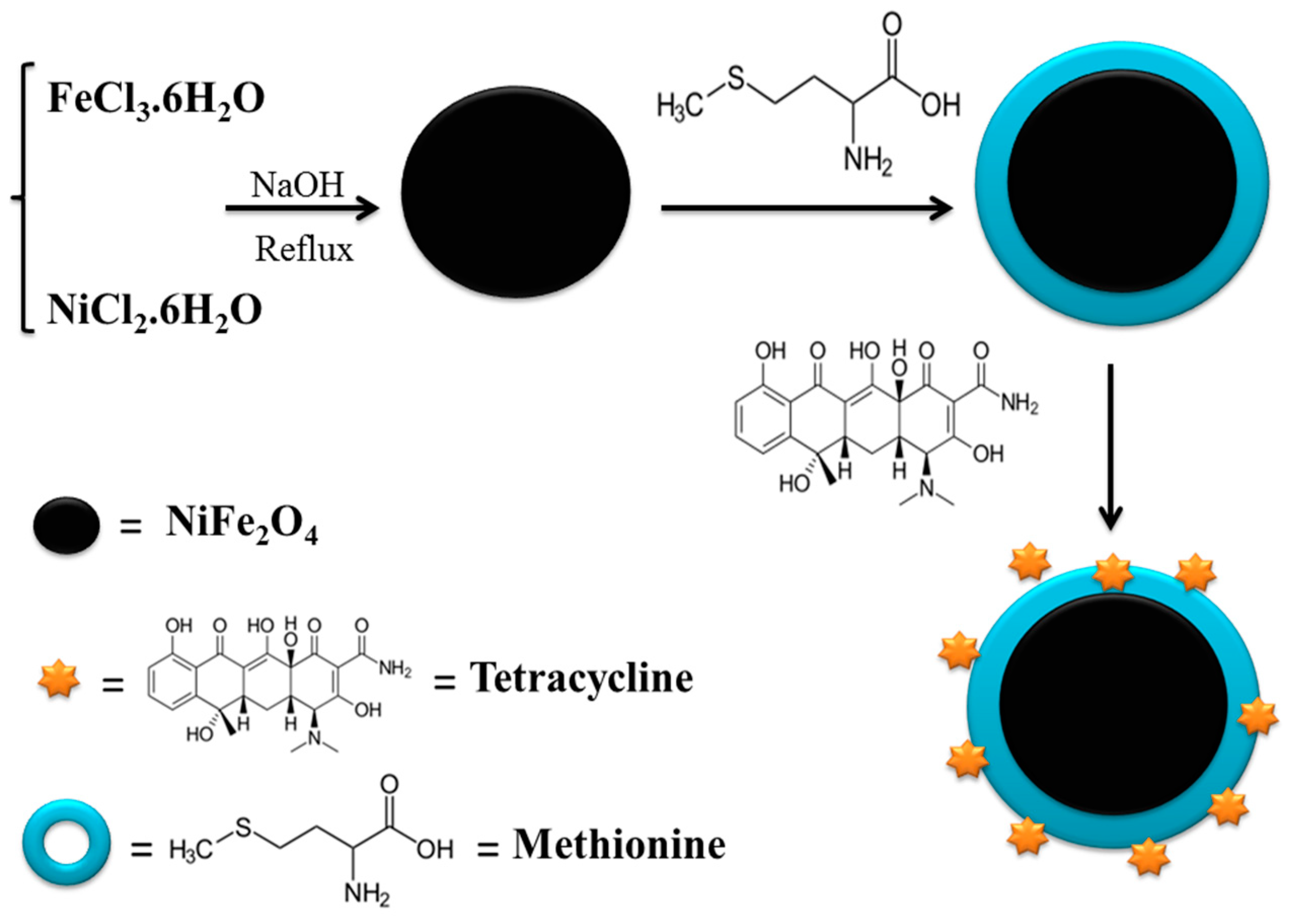
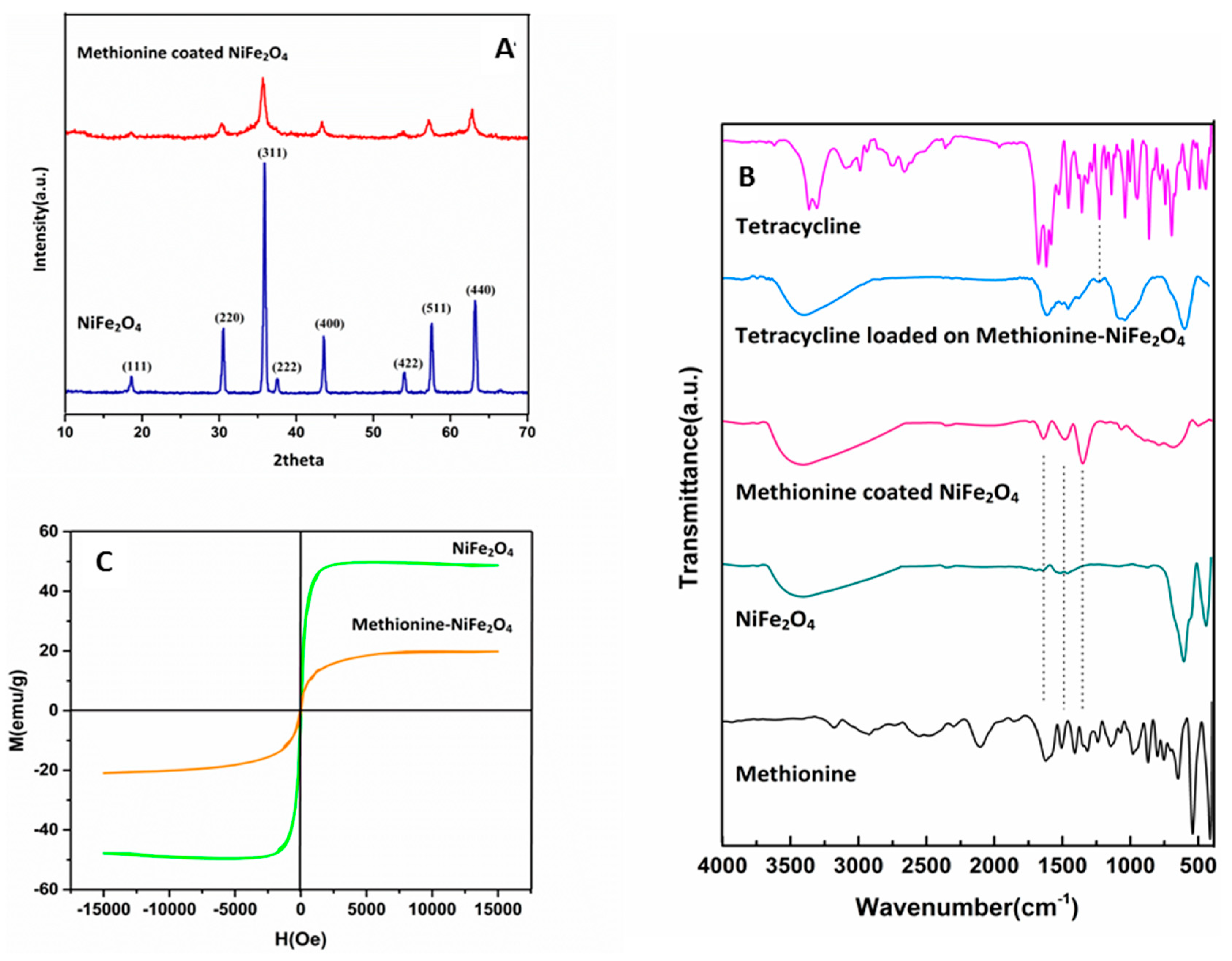
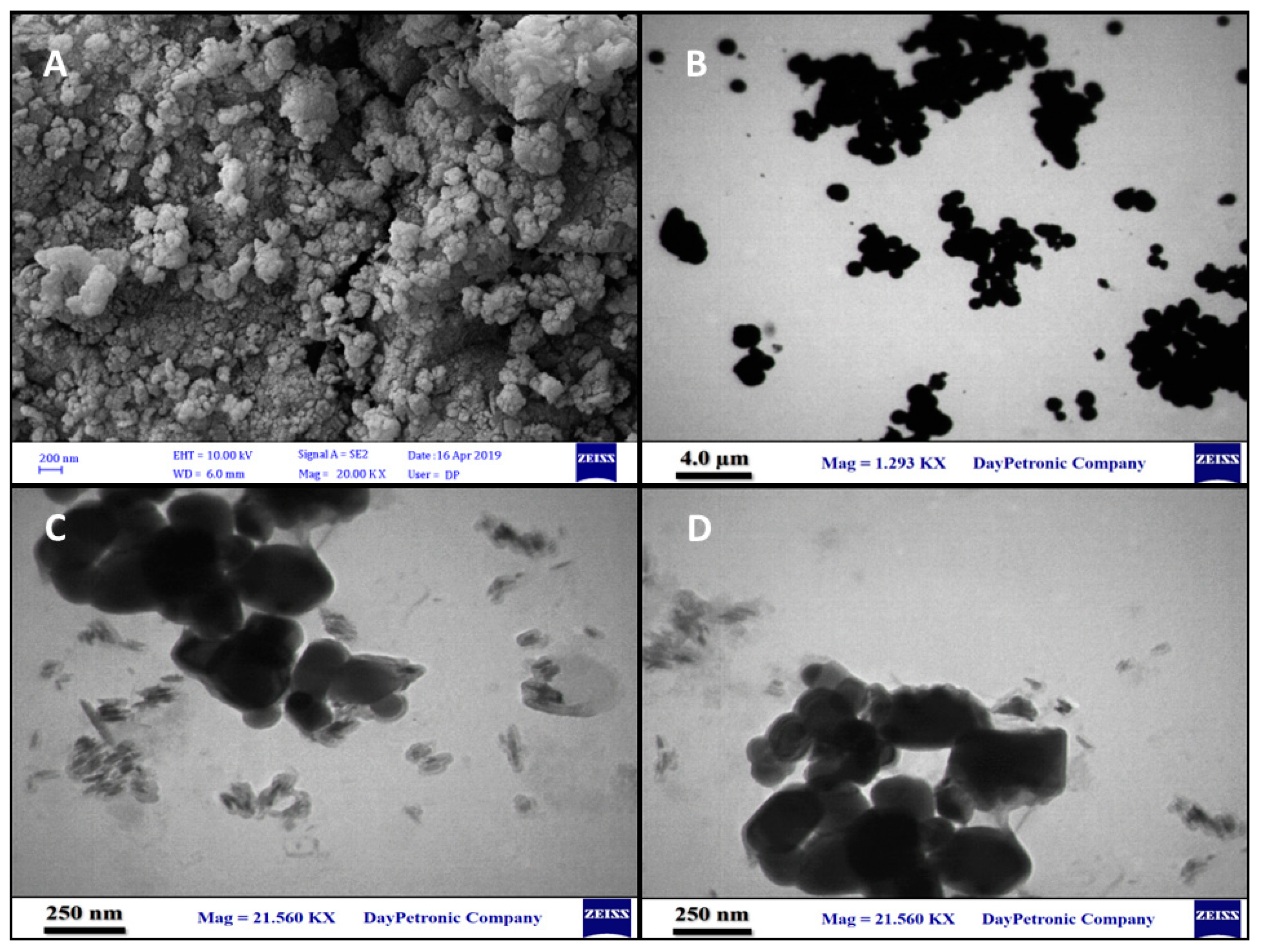


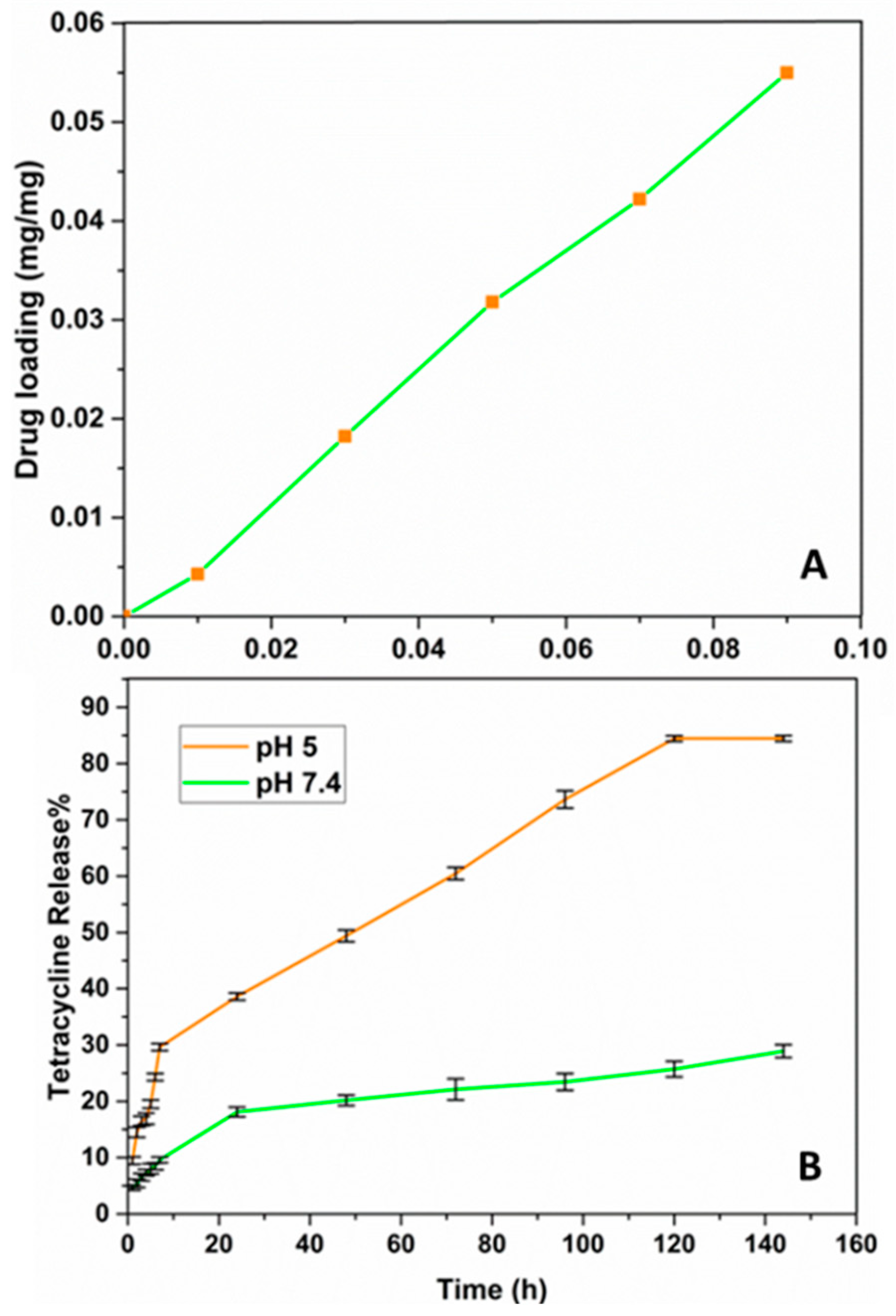

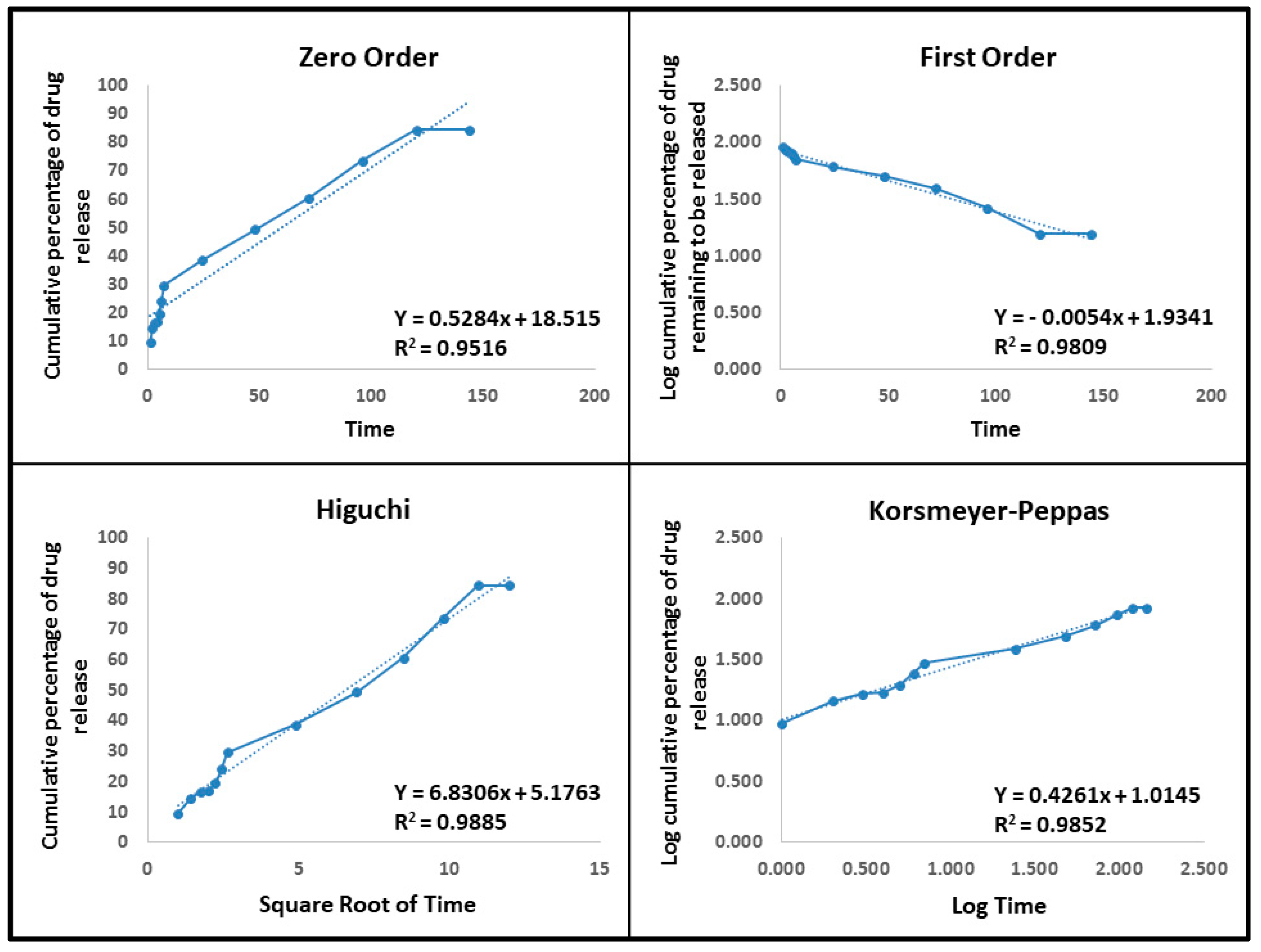

| Formulation | Size (d.nm) | PDI | Zeta Potential (mV) |
|---|---|---|---|
| NiFe2O4 | 168.5 ± 11.8 | 0.346 ± 0.02 | −32.4 + 2.4 |
| Met-NiFe2O4 | 72.4 ± 8.8 | 0.247 ± 0.06 | −27.7 ± 4.3 |
| Tet-Met-NiFe2O4 | 90.9 ± 10.6 | 0.323 + 0.02 | −31.6 ± 1.2 |
| Kinetic Models | Equation | R2 | |
|---|---|---|---|
| Met-NiFe2O4 Nanoparticles (pH—7.4) | Met-NiFe2O4 Nanoparticles (pH—5) | ||
| Zero-Order | Ct = C0 + K0t | 0.8906 | 0.9516 |
| First-Order | LogC = LogC0 + Kt/2.303 | 0.9080 | 0.9809 |
| Higuchi | 0.9712 | 0.9885 | |
| Korsmeyer-Peppas | Mt/Mꝏ = Ktn | 0.9879 (*n = 0.3775) | 0.9852 (*n = 0.4261) |
| Bacteria | E. coli | P. aeruginosa | S. aureus | E. faecalis | |
|---|---|---|---|---|---|
| MIC (µg/mL) | Free Tet | 8 | 8 | 8 | 8 |
| Tet-met-NiFe2O4 | 1 | 2 | 4 | 4 | |
| MBC (µg/mL) | Free Tet | 16 | 16 | 16 | 16 |
| Tet-met-NiFe2O4 | 2 | 2 | 8 | 8 | |
Publisher’s Note: MDPI stays neutral with regard to jurisdictional claims in published maps and institutional affiliations. |
© 2022 by the authors. Licensee MDPI, Basel, Switzerland. This article is an open access article distributed under the terms and conditions of the Creative Commons Attribution (CC BY) license (https://creativecommons.org/licenses/by/4.0/).
Share and Cite
Yeganeh, F.E.; Yeganeh, A.E.; Far, B.F.; Mansouri, A.; Sibuh, B.Z.; Krishnan, S.; Pandit, S.; Alsanie, W.F.; Thakur, V.K.; Gupta, P.K. Synthesis and Characterization of Tetracycline Loaded Methionine-Coated NiFe2O4 Nanoparticles for Anticancer and Antibacterial Applications. Nanomaterials 2022, 12, 2286. https://doi.org/10.3390/nano12132286
Yeganeh FE, Yeganeh AE, Far BF, Mansouri A, Sibuh BZ, Krishnan S, Pandit S, Alsanie WF, Thakur VK, Gupta PK. Synthesis and Characterization of Tetracycline Loaded Methionine-Coated NiFe2O4 Nanoparticles for Anticancer and Antibacterial Applications. Nanomaterials. 2022; 12(13):2286. https://doi.org/10.3390/nano12132286
Chicago/Turabian StyleYeganeh, Faten Eshrati, Amir Eshrati Yeganeh, Bahareh Farasati Far, Afsoun Mansouri, Belay Zeleke Sibuh, Saravanan Krishnan, Soumya Pandit, Walaa F. Alsanie, Vijay Kumar Thakur, and Piyush Kumar Gupta. 2022. "Synthesis and Characterization of Tetracycline Loaded Methionine-Coated NiFe2O4 Nanoparticles for Anticancer and Antibacterial Applications" Nanomaterials 12, no. 13: 2286. https://doi.org/10.3390/nano12132286
APA StyleYeganeh, F. E., Yeganeh, A. E., Far, B. F., Mansouri, A., Sibuh, B. Z., Krishnan, S., Pandit, S., Alsanie, W. F., Thakur, V. K., & Gupta, P. K. (2022). Synthesis and Characterization of Tetracycline Loaded Methionine-Coated NiFe2O4 Nanoparticles for Anticancer and Antibacterial Applications. Nanomaterials, 12(13), 2286. https://doi.org/10.3390/nano12132286










